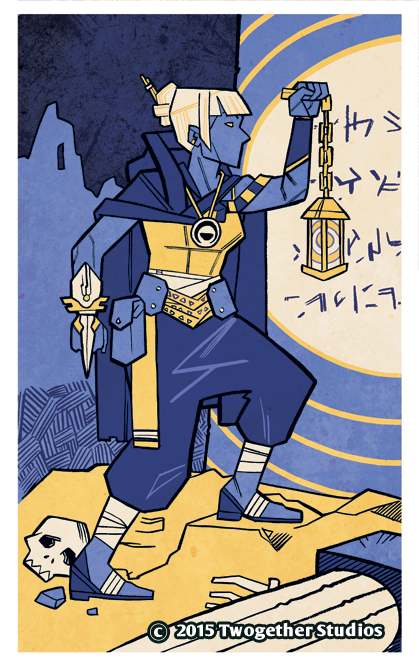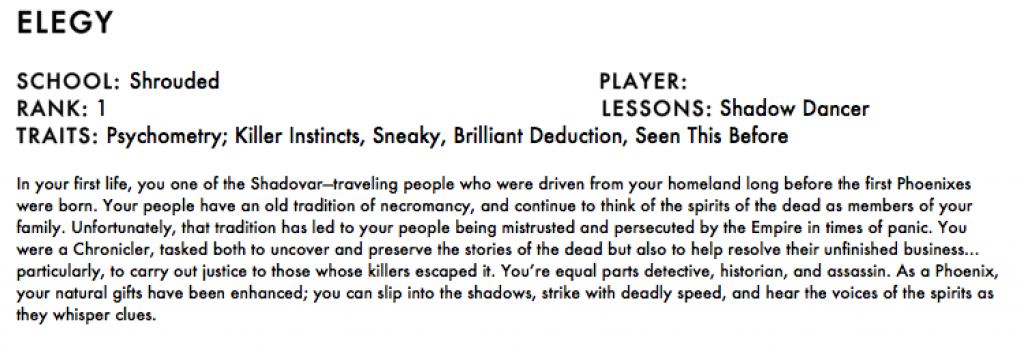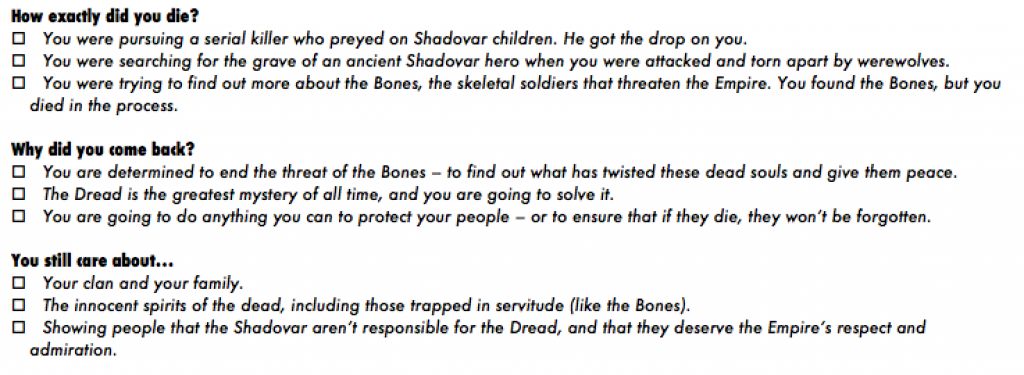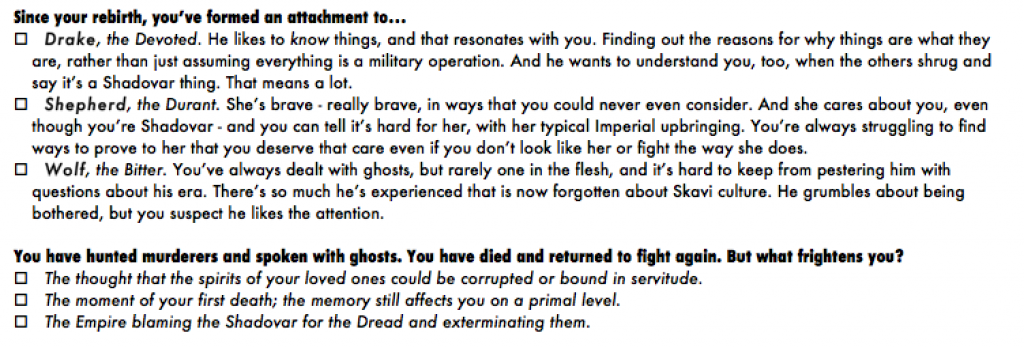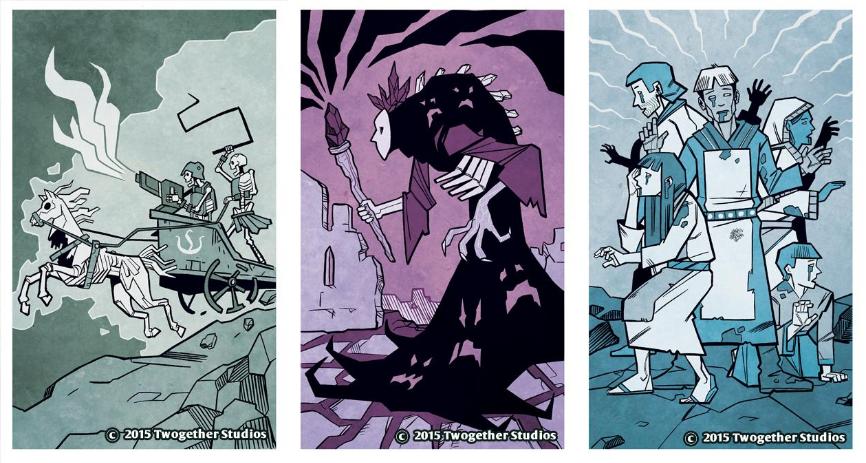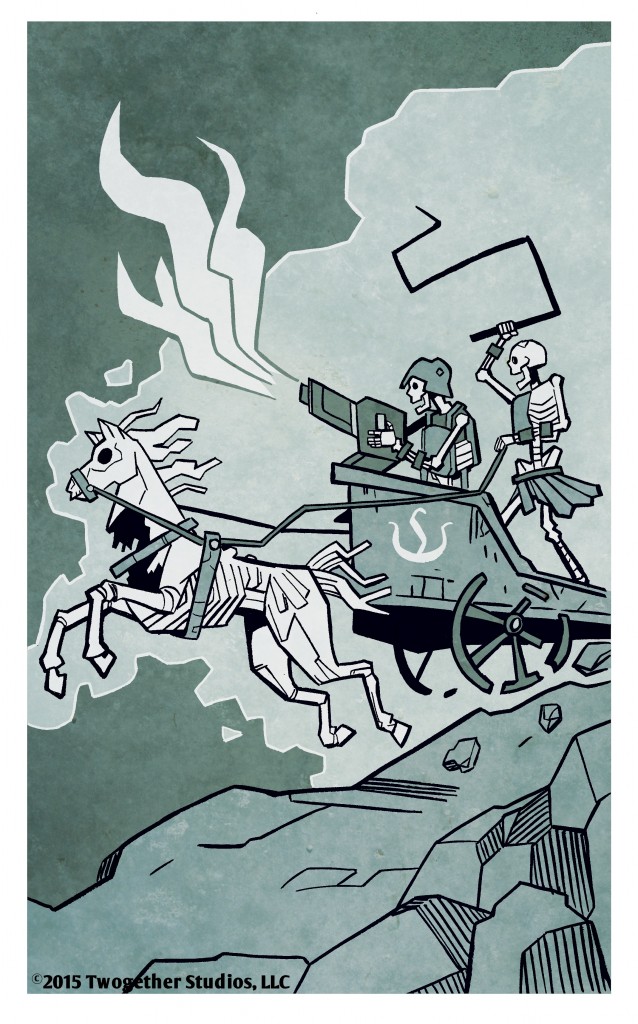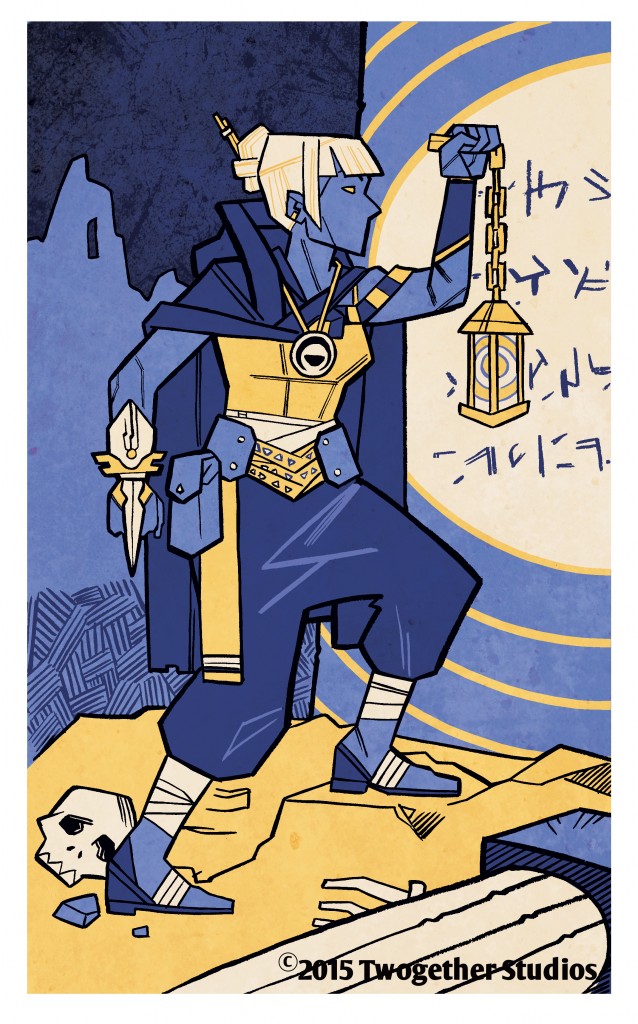It’s been a busy few months for Twogether Studios. We’re continuing to work towards the Phoenix: Dawn Command Kickstarter campaign, and I’ll be writing more about Phoenix soon. But it’s been nearly three months since my last Eberron Q&A, and I figure it’s time to get to some questions!
With the recent Unearthed Arcana release of the Eberron material, do you like the 5e work up of the material? Would you change it any further from what is currently “playtesting?” Do you think the Artificer should be re-designed in 5e as a stand-alone class, or would you like to see it supported as a Wizard (or other) type of sub-class?
At the moment, I’ve held off creating my own 5E Eberron material, beyond the vague first drafts I’ve presented for the warforged and artificer. I’m keen to develop new Eberron material, but until it’s been authorized by WotC I’ve got more things to work on than I have time. I’ve been focused on playtesting Phoenix Dawn Command for the past year, and there’s always more to do there – not to mention the Gloom variations and other projects I can’t talk about yet.
Given that: I’m glad to see WotC exploring Eberron in Unearthed Arcana. Personally, I would like to explore different approaches to the material, but the UA article specifically states that it’s an exploratory first draft… and it’s always good to explore multiple directions. The 3.5 warforged went through seven drafts before the final one. In one version warforged could attach extra limbs. In another, they absorbed the energy from magic items to gain enchantments. I don’t see a version I’d want to consider final in the UA material, but if I have an opportunity to work on official Eberron material I’ll certainly consider the UA drafts and the feedback people have given about them. Which comes back to my previous request: tell ME what you think about them, and what you would keep, add or change.
If the Du’rashka Tul tale proves to be true, could it be neutralized or dispelled? And could its effects go to Khorvaire?
For those not familiar with it, the Du’rashka Tul is mentioned on page 53 of Secrets of Xen’drik. According to legend, it is a powerful curse laid on the continent of Xen’drik by the forces of Argonnessen when the dragons destroyed the civilization of the giants. The theory is that the Du’rashka Tul is triggered any time a civilization or settlement reaches a certain level of size or sophistication. The curse drives members of the civilization into a homicidal madness; they turn on each other and destroy themselves. In this way, the dragons ensured that the giants would never rebuild their ancient power. As a result, there is evidence of a number of civilizations that have risen only to suddenly disappear over the course of the last thirty thousand years.
As it stands, details about the Du’rashka Tul are far too nebulous for me to be able to answer the questions that are posed here. So the question is how do you WANT it to work for purposes of your campaign? If you don’t want it to be possible for it to be dispelled, then it’s a curse leveled on the entire continent using a form of magic human mages can’t even begin to understand. On the other hand, if you want to be able to break it, the first thing is to define it. Perhaps it’s tied to an artifact: the skull of the titan emperor Cul’sir, engraved with draconic runes and imbued with immense magical power. First you have to find it; then you have to decide what to do with it. If it’s an artifact, it may be impossible to destroy or dispel it. You don’t know how far its radius is (it’s currently affecting all of Xen’drik). Do you drop it in the ocean and potentially destroy the civilizations of the sahuagin and merfolk? Take it back to Argonnessen and see what happens? Or might someone bring it back to Khorvaire not knowing what it is and accidentally trigger an apocalypse?
If you don’t like that approach, you could decide that it’s actually tied to a living creature. Ever since the destruction of the giants, there has been a dragon stationed in Xen’drik maintaining the Du’rashka Tul. Can you find it? Do you need to kill it, or could you just convince the guardian that the time has come to end the curse?
About the Du’rashka Tul… If it could be dispelled, would it bring about an era of colonization of Xen’drik by the great powers? If so, that could bring about potential conflict not only between the great nations of Khorvaire, but also with the Riedran empire, who already have a settlement therein. Do you think more cities would be created? And could the traveler’s curse be removed as well?
The Du’rashka Tul is an unproven myth, so I don’t think THAT’S what’s stopping the colonization of Xen’drik. The Traveler’s Curse is unquestionably real and a serious hindrance to colonization; who wants to establish a colony if you might not be able to find it later? If you posit that you remove BOTH curses, then the main issue is that you’re dealing with a continent that’s still full of powerful monsters… and the fact that Khorvaire isn’t exactly overcrowded right now. The main draw to go there is untapped resources and treasure hunting. So if you took away all the curses, I certainly think you’d get an expansion of settlements there to claim and harvest resources, in a sort of Wild West gold rush development… but I don’t think you’d see a vast proliferation of permanent settlements. Heck, if you’re looking to live on a dangerous frontier because you want a chance to strike it rich with dragonshards, you can already do that in Q’barra.
As for bumping into the Riedrans over territory, Xen’drik is the same size as Khorvaire, and KHORVAIRE still isn’t overcrowded, so it seems a little hard to imagine it happening in a hurry. Personally, I’d make it more about conflict between settlers from the Five Nations and the Dragonmarked Houses. Tharashk would definitely want to harness the resources as quickly and efficiently as possible, and any number of the other houses could see this as a way to establish lands outside of the Korth Edicts. So you could certainly have conflict between would-be independent prospectors hoping to strike it rich and dragonmarked Tharashk.
If my goal was to run a campaign focused on territorial conflict between Riedra and the Five Nations, I’d actually create a new massive island in the Lhazaar Sea. Let’s say that it’s a chunk of another plane that suddenly drops in during an odd planar conjunction – so a piece of Lamannia, filled with natural and mystical resources never even seen before on Eberron. This gives a new desirable territory directly between Khorvaire and Sarlona; lets it be small enough that forces can quickly come into conflict; places it in a region where Lhazaar pirates can pose an interesting threat; and lets in be filled with unknown threats and commodities. I think that could make for a very interesting campaign… though I’d also throw the Dragonmarked Houses in as a third player in the conflict.
There are some fairly close thematic similarities between the kalashtar and the githzerai: both use psionics, both have extraplanar connections, both are at eternal war with a race of shared origin. Were these similarities intentional when the kalashtar were designed? If so, were they meant to be a playable version of the githzerai for your campaign (ie, lacking in level adjustment)?
Interesting theory, but no. The kalashtar have the distinction of being the one new race that was mentioned in the original ten-page overview of Eberron in the setting search (though the idea of a playable doppelganger was also there in the ten-pager). For me, the defining elements of the kalashtar are that they are mortal humanoids tied to immortal spirits and their unique connection to the world of dreams, something that’s been a long-time interest of mine. My first published piece of RPG material dealt with a conspiracy of people who shared dreams and affected the world through dream manipulation (more than a decade before Inception, mind you). So no, I’m afraid it’s just a coincidence.
Meanwhile, I’ve always used the Gith as a race whose world was destroyed by the Daelkyr before they came to Eberron. I consider the Illithids to be to the Gith as the Dolgaunts are to hobgoblins; they are creatures the Daelkyr created from Gith stock. Thus the Gith are a race who have lost their world, and they despise the Mind Flayers both as the instruments of their destruction and a mockery of their people.
Also, I have read elsewhere that warforged and shifters were elements introduced to Eberron only after WotC accepted it as their contest winner. In the pre-WotC conception of Eberron, did elements related to warforged and shifters exist?
That’s not quite true. The Warforged and Shifters weren’t present in the TEN page submission, because I made the assumption that WotC wouldn’t be interested in adding lots of new races when so many already existed. As such, the kalashtar were the only NEW race I presented. When WotC chose Eberron as a finalist, I had the opportunity to talk to the D&D R&D team and they discussed the aspects of Eberron they liked and what they wanted to see more of in the 100-page final story bible. In particular, they wanted to see more races – specifically races that addresses the magic-as-part-of-life aspect of the world. Sentient war golems and playable lycanthropes both fit that bill. So warforged, shifters and changelings were all in the 100-page story bible that was submitted in the final round of the setting search… and then after Eberron was selected, they were further defined and refined for inclusion in the 3.5 Eberron Campaign Setting.
Is it conceivable for a 5e Great Old One Warlock to have a bond with a Quori? If so, how would you interpret a warlock bond with a Quori outside of the Kalashtar case?
You can certainly have a Great Old One Warlock tied to Dal Quor. Here’s a few ways I could see it working.
Higher Power. The Warlock isn’t dealing with the lesser entities of the Quori; rather, he is dealing directly with one of the greater spirits of the plane. If he tends towards evil, this would be the dominant spirit, il-Lashtavar, the Darkness that Dreams. If he’s benevolent, this would be il-Yannah, the Dawn Yet To Come.
Essentially, the Quori are the creations and servants of il-Lashtavar. If a PC warlock is directly chosen by the great spirit, he is being elevated above the Kalashtar or even the rank and file members of the Dreaming Dark; among the Quori, only the Devourer of Dreams communes directly with il-Lashtavar. This would make the PC a remarkable special person… as a PC should be. The question then becomes HOW the power communicates with him and why. Does it have specific requests, and if so why can’t those be handled by Kalashtar or Quori? Or does it simply need a mortal vessel for some other reason?
Enemy of Higher Power. Twist the concept of the Warlock. The PC isn’t a SERVANT of il-Lashtavar. Instead, the Warlock has essentially hacked into il-Lashtavar and is draining its power by casting spells. This concept works well if you don’t plan for a lot of direct warlock-patron interaction. Alternately, you could say that the power is taken from il-Lashtavar, but the patron is il-Yannah; by weakening the darkness, you speed the coming of the light.
Quori Stooge. The player’s patron is a malevolent quori, likely one of the most powerful of the Kalaraq (such as the Devourer of Dreams). It is posing as some awesome dream entity; it is only through play that the PC will realize that the missions he’s being given are pushing the world in a subtly sinister direction. At this point he’ll need to find a new patron, such as…
Lost Kalashtar. The rebel kalaraq Taratai started the Kalashtar rebellion, but all of her kalashtar hosts have been eliminated and her spirit is lost, presumed to have been reabsorbed by il-Lashtavar. But perhaps it still survives, and has managed to reach out to the warlock. While this bond wouldn’t be the same as being a Kalashtar, it would make the warlock incredibly important to the Kalashtar.
If you named a bunch of books, or films, or TV shows, or whatever, whose inspiration has been critical in creating Eberron, in a sort of multimedia Eberron Appendix N, which would they be?
I could swear there’s a two page list in one of the 3.5 sourcebooks, but a quick search isn’t turning it up. Putting together a list of every book, show or film that I think could possibly inspire people working on Eberron would take more time than I currently have. For example, I have a FEELING that some people might find China Mieville’s books to be inspiring for Eberron, but I’ve never actually read them (which is embarrassing, as all accounts suggest they are awesome – I’ve just never gotten around to it). Likewise, I’ve never played a Final Fantasy game. So I’m going to list a few things, but these are simply a few things that personally inspired me – not every possible source of inspiration.
Raymond Chandler, Dashiell Hammett and almost any Film Noir movie.
The original one sentence description of Eberron was “Raiders of the Lost Ark and The Maltese Falcon meet Lord of the Rings.” Anything in this vein will help inspire adventures tied to dirty dealings on the mean streets of Sharn… and I’ve always described Graywall in Droaam as “Casablanca with ogres.” For what it’s worth, I prefer The Maltese Falcon as a movie and The Big Sleep as a book.
Two-Fisted Tales of Adventure!
The Mummy. Any Indiana Jones movie. Any Republic serial (such as “Nyoka and the Tigermen”). Anything by Edgar Rice Burroughs or Jules Verne. I originally came up with the idea for Eberron because I’d spent a few years working on a pulp-flavored MMORPG that ended up being cancelled, and I’d been watching a LOT of pulp serials.
Neuromancer
William Gibson’s Neuromancer is one of the early cyberpunk novels. It combines aspects of a dystopia future with some basic film noir tropes. There are certainly ways in which the Dragonmarked Houses are inspired by the classic cyberpunk megacorps, with the basic question of what happens when corporate power equals or exceeds the relevance of nations. Almost any cyberpunk novel can provide inspiration for a House-heavy game, but Neuromancer remains my favorite.
Steven Brust
Brust’s Taltos series are pulp stories set in a fantasy world, and deal with many of the same issues as Eberron… though Dragaera is more magically advanced than Eberron; teleportation and resurrection are basic tools available to civilization and everyone effectively has a psionic cell phone. I’ve often considered running a Taltos-style campaign in Eberron, in which the PCs are small time operators in the Boromar Clan trying to hold their turf and expand their reputation and influence. I also like Brust’s Phoenix Guards series, in part because it’s set in an earlier age and there’s an opportunity to see how the science of magic evolves. And as long as we’re mentioning The Phoenix Guards, you also can’t go wrong with anything by Alexandre Dumas.
Phillip K. Dick
I prefer PKD’s short stories to his novels, but I love the questions he raises in his work. The warforged essentially spring from my long love of Blade Runner, bringing us back to cyberpunk. What is the nature of life? What do you do if you were made to be a weapon and there is no war?
H.P. Lovecraft
If you’re going to get into the Cults of the Dragon Below or the Lords of Dust, you should delve into some Lovecraft.
I’m going to stop here because I could keep this list going for pages, and I’m out of time… but anyone reading, post your inspirational films and stories in the comments! For honorable mention, as authors I’ve read and enjoyed who may or may not have directly influenced Eberron: Jack Vance (anything to do with the Dying Earth); Tanith Lee (Night’s Master or Tales From The Flat Earth); J. R. R. Tolkien; George R. R. Martin; Michael Moorcock; Robert E. Howard; Sheri S. Tepper; Neil Gaiman; Patrick Rothfuss; William S. Burroughs (maybe not useful for Eberron, but great if you’re running Over The Edge)… I’ll stop there, but I’m sure I’ll think of a dozen more as soon as I post this.
And now, the Thrane and the Silver Flame questions…
Is there any cardinal who is seriously opposed to Krozen or is suspicious about him? Does Jaela Daran mistrust Krozen?
As with many things about Eberron, it depends on your campaign. In MY campaign, I might decide to have Jaela be a canny politician who’s quite suspicious of Krozen and seeks personal agents to help her carry out personal missions. However, more often I cast Jaela as the truly spiritual leader of the Church, who has little interest in politics and thus tends to trust Krozen and rely on him to handle that side of things. I hate to say this with so many questions, but it’s really a question of how you want the story to go; there’s no wrong answer.
In the 4e ECG it’s mentioned that Aundair refused to return lands to Thrane and that is why Thrane kept Thaliost. Why did Aurala attach more importance to those lands than to such a city? Magic, strategic importance, or other settlements?
Personally I see this as an oversimplification. It’s not that Thrane offered to return Thaliost and Aundair said “No deal,” it’s that each nation had made territorial gains and neither one was willing to give ground. Remember that Aurala in particular believes in the righteousness of her claim to the throne of Galifar and has the least interest in the peace process. What’s been said in other sourcebooks is that Aundair claimed the land that is currently home to Arcanix during the war; note that as Arcanix is a set of floating towers, it was moved to this location to help secure the claim. However, if you consider what makes specific locations strategically important in Eberron, if I were to write something about Arcanix in the future I’d propose that the current location is a powerful manifest zone that is valuable for the research conducted at Arcanix… which would explain both why Aundair attaches such importance to the location, why they moved the university there, and why they aren’t prepared to surrender it.
Wasn’t it mentioned somewhere that Overlord Sul Khatesh is imprisoned under Arcanix?
Good catch! You’d think I’d remember that, since I wrote it (it’s on page 31 of the 4E ECG). In my opinion, this isn’t something anyone KNOWS – it’s a fact for you, the DM. But it’s an excellent reason to say “Arcane magic is remarkably effective in this region and people are far more likely to make amazing breakthroughs in arcane studies.” People think it’s because of a manifest zone, but in fact it’s the influence of Sul Khatesh. So Aundair does believe it’s an ideal site for the University. If I was looking for a plot hook, I’d have some Church scholar figure it out and Thrane suddenly urgently pushing to take back the region, which threatens to escalate into open conflict.
What kind of discrimination (if any) would an aristocrat face who is a devoted follower of the Silver Flame but who holds lands in Cyre, Breland, Aundair, etc. Having that kind of dual loyalty would strike me as fertile ground for rivals to nibble away at holdings.
The Silver Flame was widespread across Galifar before the Last War. Ever since the Lycanthropic Purge it’s been especially strong in Aundair, which has always been the stronghold of the Pure Flame. However, devotion to the Flame DOES NOT EQUAL LOYALTY TO THRANE. Many of the Purified don’t approve of the theocratic government of Thrane, asserting that involving the Keeper and cardinals in secular politics distracts the Church from its true mission and breeds corruption.
The purpose of the church is to protect the innocent from supernatural evil. Mortal politics don’t enter into the equation. So a Brelish noble who is loyal to the Flame can absolutely oppose the soldiers of Thrane when they are engaged in military action on behalf of Thrane. If, say, an army of demons pops up, all of the Purified would be expected to join forces against this supernatural threat; once that’s out of the picture they could return to their secular conflict.
So: an Aristocrat who is devoted to the Flame is unlikely to suffer significant prejudice in any nation other than Karrnath. However, a noble who vocally supported his national government being dissolved in favor of Thranish theocracy would likely suffer trouble.
How prolific is the CoSF in Karnath and to what degree would the Karnathi Purified have been persecuted?
The CoSF has never had a strong presence in Karrnath. The people of Karrnath are pragmatic and pessimistic by nature, and the Silver Flame is fed by optimism and altruism. Beyond this, the Blood of Vol was deeply rooted in Karrnath a thousand years before the modern CotSF was even formed… and the Blood of Vol is fundamentally opposed to the Silver Flame, as it embraces what the Church would call “Supernatural Evil”. So it was weak to begin with, and most SF loyalists would have risen in revolt when the state embraced the Blood of Vol as the state faith and began employing undead in the military. This is also the reason Thrane and Karrnath have the deepest emnity of any of the Five Nations. There are surely some in Karrnath who embraced the faith of the Flame… and even if most immigrated or revolted during the war, some could have chosen to hold position and endure so that they could continue to protect the innocents of Karrnath. But they would certainly be viewed with distrust and disdain by those around them, and could easily be accused of treason (true or not).
Side note: While the state no longer supports the Blood of Vol, the cultural tone of Karrnath is still a better match for the BoV – which is a bleak faith based on the concept that the universe and the gods are our enemies and ultimate dissolution is inevitable – than the Silver Flame.
After the Day of Morning, Thrane turned away Cyran refugees. Would the Purified of Cyran birth been exempt from this prohibition?
Well, here’s the thing. In the extended aftermath of the DoM I could see Thrane refusing to admit refugees. However, in the IMMEDIATE aftermath, it’s the only nation I CAN’T imagine refusing refugees. The entire purpose of the church is to DEFEND THE INNOCENT FROM SUPERNATURAL EVIL. Not “Defend the citizens of Thrane” or “Defend the followers of the Flame”, DEFEND THE INNOCENT. The Mourning is about as “supernatural evil” as things get. It is utterly bizarre to suggest that when faced with clear evidence of supernatural attack that anyone devoted to the Flame would turn back civilians to fend for themselves.
So frankly, the first thing I’d do would be to rewrite whichever history book says that they turned away refugees in the immediate aftermath. After that, I’d have to come up with an explanation that would make sense to me as to how they would justify turning away refugees in a long-term situation. I do feel that they would accept anyone who wished to serve the church itself, because again, the purpose of the church transcends politics. I could see AUNDAIRIAN Templars aligned with the Pure Flame taking such actions (turning back any who didn’t support the Flame) because the Pure Flame is an extremist movement that frequently ignores the core principles of the faith (as shown by Archbishop Dariznu burning people)… but it’s very out of character for Thrane Templars, and personally I’d ignore it in any campaign I run.
I can see the explanation for turning away refugees to involve something along the lines of, “In our capacity as worldly rulers, we are forced to separate ourselves from our spiritual roles as leaders of the Church. So, it is with a heavy heart we are forced to look at what is good for Thrane, rather than what is good for for the suffering souls of Cyre. We are therefore closing our borders to any, and all, refugees from the event known as the Day of Mourning.”
Certainly. If I had to come up with an explanation for it, it would the the reasons that any government turns away refugees. I’m just saying that of all the Cyre-adjacent countries, Thrane seems like the strangest one to make that decision. Consider our options…
- Karrnath. A very logical choice. Not only are they a highly pragmatic, militant culture used to making harsh decisions, they are also called out as dealing with famine and thus legitimately lacking the resources to suddenly support refugees. If I was picking one of the Five Nations to turn away refugees, it would be Karrnath.
- Breland. On the one hand, you have Breland’s egalitarian character; on the other, Breland is often also presented as pragmatic and opportunistic. It wouldn’t surprise me to have some corrupt border patrols lining their pockets in exchange for safe haven.
- Thrane. The odd duck. Thrane isn’t noted as suffering from a crippling lack of resources that would prevent it from accepting refugees. The fundamental principle of the Silver Flame is protecting the innocent from supernatural threats… like the Mourning. Thrane abandoned its secular government in favor of a theocracy based on this faith, and this faith is widespread throughout the nation – so even if the secular leaders gave such an order, I’d expect many border forces to ignore it and follow their faith. Bear in mind that when Aundair was threatened by a plague of lycanthropy a few centuries early, an army of Thranes threw themselves in harm’s way to protect their neighbors. They are the one nation with a proven history of altruistic behavior. Now, I have no problem with Thrane turning away immigrants under any other circumstance… but specifically turning away refugees fleeing from a horrific supernatural threat is bizarrely out of character for Thrane.
Historically, Thrane has the least consistency in its presentation by different authors. The corruption is often blown out of proportion, when a) the CotSF isn’t supposed to have MORE corruption than any other faith in Eberron, it’s simply that there IS corruption even in this altruistic institution; and b) the majority of that corruption is based in Breland. The zealotry becomes a focus, when Aundair is supposed to be the stronghold of the Pure Flame and Thrane the seat of the moderate faith. Heck, we can’t even get consistency on the fact that archery is an important cultural tradition.
So: there is a book that says that Thrane ruthlessly turned away refugees on the Day of Mourning. I could come up with an explanation for that if I had to. But in MY campaign, I’m simply going to ignore it and say it was Karrnath that turned people away… which was an unfortunate necessity due to their limited resources.
So, in your view the Cyran refugees problem presented in the books happening in Breland, it also exists in Thrane? With ghettos and maybe a big refugee camp( like a smaller New Cyre). If not, why the refugee problem exists only in Breland? They have gone there BECAUSE of New Cyre? The Thrane refugees adopted quickly the faith and culture of Thrane and are more keen to mingle and adapt than the Brelanders?
All good questions! To be clear: My issue is the concept that Thrane would turn away people fleeing from a severe supernatural threat. Once that imminent threat is over, I have no issue with them placing political reality ahead of altruism. It’s the same idea that Thrane followers of the Flame can fight Brelish followers of the Flame, but if that demons appear they should both stop fighting to deal with them. For followers of the Flame, a supernatural threat should override political concerns – but once that threat is resolved, politics are back in play.
I believe that Cyran refugees are a problem across Khorvaire (and heck, as far away as Stormreach). If there’s a nation where they aren’t a problem, I’d pick Karrnath… both as the nation legitimately most likely to reject them in the first place (famine!) and as the nation most use to draconian enforcement (Code of Kaius). However, I think that Breland is unique in embracing the refugees… specifically creating New Cyre, a place where their culture is allowed to flourish. Thrane could well be pushing its refugees to abandon their culture and assimilate into Thrane and the Church… given which, those with the means to do so would likely have made their way to New Cyre.
So if I was creating a Flamekeep sourcebook, I would certainly address the presence of Cyran refugees within it. But again, I’m happy with the idea that they are under significant pressure to assimilate, and that NEW refugees aren’t welcome. It’s not that Thrane is the kindest, gentlest nation; it’s that it is specifically altruistic when it comes to fighting supernatural threats, and the actual event of the Mourning would fall under that umbrella.
The accounts of the spread of the Mourning suggest it was very fast (it was the Day of Mourning, not the Week of Mourning or the Month of Mourning, and the Field of Ruins was certainly overrun that same day). If that is the case, how are there any significant number of refugees at all? For that matter, how was there time for any official policy on refugees to be formed? It doesn’t seem like anyone other than border guards would have had time to react before the refugees were already there.
Another excellent set of questions. You’re absolutely correct: it’s called the Day of Mourning for a reason. The first point is that the effects of the Mourning bizarrely conform to a particular set of borders. In my opinion, the bulk of the “refugees” weren’t actually in Cyre when the Mourning occurred; they were soldiers and support staff either in enemy territory or land temporarily seized. This raises one of the long-term issues of dealing with Cyran refugees: most of them were actually enemy combatants, and the war wasn’t over.
In terms of civilian refugees, start with those already out of the borders. Add to those communities on the very edge of Cyre… it was the Day of Mourning, not the Hour of Mourning, after all. The cloud could be seen from a great distance away, and you could easily have had a few places where there was communication – a Speaking Stone station sends a message out saying “Cloud approaching” and then drops off the grid. People on the edge who discover that no inner city is responding might have time to make it to the border… though given that they wouldn’t have known it would stop at the border, odds are good that you’d just have general panic and “SOMETHING IS COMING!!!” – again, the sort of supernatural threat Templars are supposed to defend the innocent from.
HOWEVER, at the same time, it was a time of war and for all border guards would know, it could be a trick. In a time of war, it’s not unreasonable for any nation to act with fear and suspicion; it’s simply that of all the nations, Thrane has the most compelling reason in the very short term to set that suspicion aside to defend those endangered by a supernatural threat.
So for refugees, this gives us Cyrans in enemy territory already; civilians on the very edge who were able to flee before the Mourning reached them; and one more category: survivors. The effects of the Mourning weren’t entirely predictable, and not everyone exposed to it died. The Storm Hammers in Stormreach (City of Stormreach, p.73) are a group of such survivors. So you could have had people in border communities who didn’t escape – but who survived and then fled in a panic.
In any case, you’re right: we’re not talking about large numbers of refugees, and it would be the border guards that would be making the initial decision.
What’s your take on the event leading to the creation of the Church of the Silver Flame?
Well, the 3.5 ECS has this to say…
In 299 YK, the event that started the religion of the Silver Flame took place. In that year, a terrible eruption split the ground and a great pillar of crimson fire emerged from the resulting chasm. No one understood the significance of the blazing column of flame, but most who dared approach it felt unrelenting malevolence in its radiating heat… Tira Miron, a paladin dedicated to Dol Arrah, received a powerful vision about this strange fire while exploring the western reaches of the realm. In her vision, a great rainbow-winged serpent warned her that a terrible evil was emerging in the east, riding crimson fire from the depths of Khyber itself. Tira rallied the forces of Thrane and defeated the dark creatures that had come to venerate the crimson fire and help free the malevolent entity trapped within its flames.
A key point here that’s sometimes missed is that Bel Shalor was never truly free; he just got VERY VERY close to being released. This caused the appearance of demons. Some were likely drawn to the region from other points (such as his followers in the Lords of Dust), but many were probably just released from the Flame itself in advance of him… imagine a fishing net pulled from the ocean with one big fish trapped in it and hundreds of smaller fish tumbling out through the gaps. So: Demons were afoot in Thrane, and their numbers were increasing over time. However, I think that the actions of mortals were more noticeable than the presence of demons. As Bel Shalor’s influence over the region grew, he brought out the worst in people. As noted in the 4E ECG, “People who fall under his sway become selfish and cruel, turning on one another instead of standing against him.” So you’d see feuds and vendettas taken to extremes, the rise of petty tyrants, widespread banditry, and far worse. It makes me think a little of Patrick Rothfuss’s Kingkiller Chronicles – there ARE demons in the darkness, but the people are more concerned with increasing banditry, war, taxes and the like… not realizing the darker forces that are influencing things.
Tira becomes aware of the threat, but in my opinion she doesn’t just rush over and dive in. Personally, I feel that it took her the better part of a year to prepare – gathering mortal and immortal allies, traveling across Khorvaire and even the outer planes to learn about Bel Shalor and how he could be defeated. In my personal campaign, she went to the Demon Wastes to obtain Kloijner; the greatsword was forged by the couatl (technically it’s a couatl frozen in steel) in the Age of Demons and was previously in the possession of the Ghaash’kala orcs.
In coming back through Thrane, the first step was uniting people and helping them break free of Bel Shalor’s influence; then she led these forces and her allies to the site of the breach, where she defeated the demons and sacrificed herself to force Bel Shalor back into the Flame. Those she left behind then laid the foundation of the modern church. As a side note, in my opinion Tira was essentially one member of a party of adventurers. Dragon 417 includes an article called Miron’s Tears, which identifies an Avenger named Samyr Kes as one of these allies. Others haven’t been named – but these would be the people who established the Church.
One other point: While Bel Shalor was never fully released, it seems likely that his prakhutu, The Wyrmbreaker (described on page 30-31 of the 4E Eberron Campaign Guide) would have been commanding the forces defending the breach… so likely Tira and her allies had to defeat him before they could reach the Flame.
Phew! That’s all for this installment. I’ll certainly let you know as soon as I have any news about Eberron development of 5E. Next up: More about Phoenix: Dawn Command!
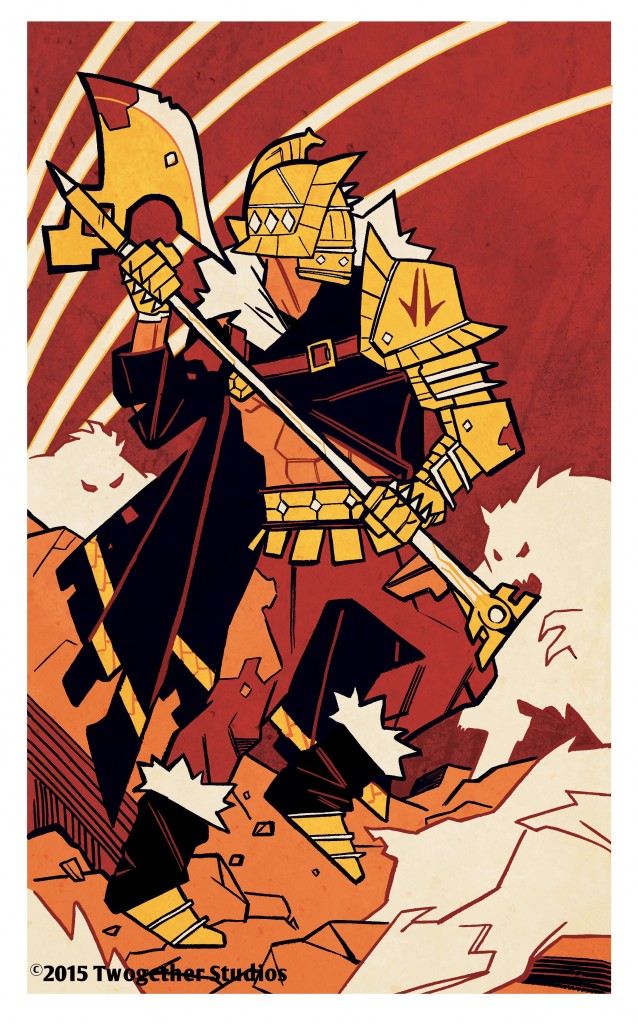 In Phoenix: Dawn Command (now funding on Kickstarter) you normally build your character from the ground up, choosing your School, your Traits, and your lessons. You answer questions about your character: Who were you in your first life? How did you die? What gave you the strength to come back? You can watch a video overview of this process here. However, we also provide a set of pregenerated character in case you want to get started right away. Each of these character provides a glimpse into different aspects of the world. Over the next few days I’m going look at a wing of Phoenixes, and these characters will be featured in the gameplay video we’re releasing later in the campaign.
In Phoenix: Dawn Command (now funding on Kickstarter) you normally build your character from the ground up, choosing your School, your Traits, and your lessons. You answer questions about your character: Who were you in your first life? How did you die? What gave you the strength to come back? You can watch a video overview of this process here. However, we also provide a set of pregenerated character in case you want to get started right away. Each of these character provides a glimpse into different aspects of the world. Over the next few days I’m going look at a wing of Phoenixes, and these characters will be featured in the gameplay video we’re releasing later in the campaign. The Bitter school is driven by aggression and force. Wolf’s Endless Rage allows him to enter a berserk state that increases his power at the cost of his defense. His Reckless Trait lets him ignore defense entirely to launch a strike at a would-be attacker. His other Traits – which aren’t innately tied to his School – still reflect his aggressive nature. This list doesn’t include the core lessons common to all Bitter Phoenixes, so there’s a little more to a character than you see here.
The Bitter school is driven by aggression and force. Wolf’s Endless Rage allows him to enter a berserk state that increases his power at the cost of his defense. His Reckless Trait lets him ignore defense entirely to launch a strike at a would-be attacker. His other Traits – which aren’t innately tied to his School – still reflect his aggressive nature. This list doesn’t include the core lessons common to all Bitter Phoenixes, so there’s a little more to a character than you see here.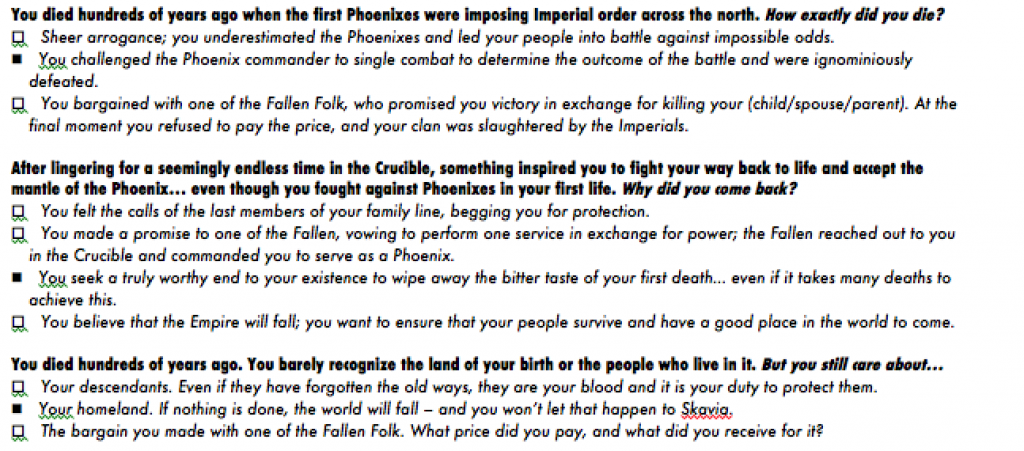 Our Wolf is fairly straightforward. He was a mighty warrior in the past, but underestimated the Phoenixes. Shamed by his defeat, he seeks to die a truly worthy death… which is a good match for his Reckless and Death Wish Traits. But he still cares about his homeland, and he won’t let it be consumed by the Dread.
Our Wolf is fairly straightforward. He was a mighty warrior in the past, but underestimated the Phoenixes. Shamed by his defeat, he seeks to die a truly worthy death… which is a good match for his Reckless and Death Wish Traits. But he still cares about his homeland, and he won’t let it be consumed by the Dread. Wolf is a fierce warrior, but everyone’s afraid of something. Our Wolf didn’t have any dealings with the Fallen, so he takes the Phoenix who slew him as his greatest fear. Meanwhile, he finds a connection with Elegy.
Wolf is a fierce warrior, but everyone’s afraid of something. Our Wolf didn’t have any dealings with the Fallen, so he takes the Phoenix who slew him as his greatest fear. Meanwhile, he finds a connection with Elegy. The Skavi have a tradition of masks, which was particularly important in Wolf’s time; you never want the Fallen Folk to know your face. His Talon is his default weapon.
The Skavi have a tradition of masks, which was particularly important in Wolf’s time; you never want the Fallen Folk to know your face. His Talon is his default weapon.
